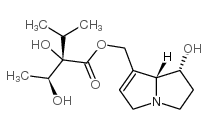Lycopsamine
Modify Date: 2024-01-08 18:44:29

Lycopsamine structure
|
Common Name | Lycopsamine | ||
|---|---|---|---|---|
| CAS Number | 10285-07-1 | Molecular Weight | 299.36300 | |
| Density | 1.26g/cm3 | Boiling Point | 463.3ºC at 760mmHg | |
| Molecular Formula | C15H25NO5 | Melting Point | N/A | |
| MSDS | N/A | Flash Point | 234ºC | |
Use of LycopsamineLycopsamine, a pyrrolizidine alkaloid, is a potential antitumor agent isolated from Eupatorium maculatum L.[1]. |
| Name | [(7R,8R)-7-hydroxy-5,6,7,8-tetrahydro-3H-pyrrolizin-1-yl]methyl (2S)-2-hydroxy-2-[(1S)-1-hydroxyethyl]-3-methylbutanoate |
|---|---|
| Synonym | More Synonyms |
| Description | Lycopsamine, a pyrrolizidine alkaloid, is a potential antitumor agent isolated from Eupatorium maculatum L.[1]. |
|---|---|
| Related Catalog | |
| References |
| Density | 1.26g/cm3 |
|---|---|
| Boiling Point | 463.3ºC at 760mmHg |
| Molecular Formula | C15H25NO5 |
| Molecular Weight | 299.36300 |
| Flash Point | 234ºC |
| Exact Mass | 299.17300 |
| PSA | 90.23000 |
| Vapour Pressure | 1.57E-10mmHg at 25°C |
| Index of Refraction | 1.567 |
| RIDADR | UN 1544 |
|---|---|
| Packaging Group | III |
| Hazard Class | 6.1(b) |
| retronecine-O(9)-(-)-viridifloryl ester |
| Retinol,3,4-didehydro-,hexadecanoate |
| 3-Dehydroretinyl palmitate |
| 3,4-Didehydroretinol hexadecanoate |
| Retinylpalmitat |
| 3-Dehydroretinol palmitate |
| (+)-Lycopsamine |
| dehydroretinyl palmitate |